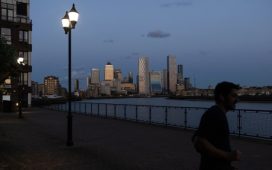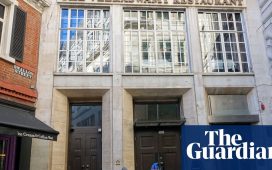Tokyo stocks are bumping at about 34-year highs and foreign investors are pouring money into the market, but Japan’s Aozora Bank has reminded the country that its lenders retain the ability to deliver nasty shocks.
Since the mid-sized bank revealed this month that exposure to the crisis-hit US office market would push it into an annual loss, analysts and investors have been scrambling to assess whether such dangers could be widespread in the Japanese financial sector.
Shares in Aozora, which the government saved from outright collapse 25 years ago in the aftermath of the collapse of Japan’s property bubble, have been trading about a third lower since the February 1 profit warning.
The unsettling announcement marked a sudden, qualitative change in Aozora’s risk assessment, its ability to pay dividends and potentially its future as an independent bank. For Japan’s highly fragmented banking sector, long resistant to consolidation, it was a reminder of how quickly stability can evaporate.
Out of all Asian lenders, “Japanese banks look the most vulnerable to US CRE [commercial real estate] risk”, wrote Citi analyst Andrew Coombs in a research note, though he added the risk “mostly concentrates” in smaller banks such as Aozora.
The good news for investors is that Aozora appears unique among Japanese banks in the scale of risk it has piled up via non-recourse loans — for which the lender’s claim is limited to pledged collateral — against US offices in Chicago, San Francisco and other US cities.
Aozora’s outsized exposure to the US office market had already caught regulators’ attention but had, until this month, seemed under control.
“It’s kind of an idiosyncratic bank . . . and has been a monitoring priority,” said a senior official at Japan’s Financial Services Agency. The FSA official said none of the large banks and about 100 smaller lenders it monitors had the same level of exposure as Aozora.
Analysts said any idiosyncrasy of Aozora related to its tormented history. The bank originated as the Nippon Credit Bank, which was among the highest-profile casualties of the protracted fallout from the collapse of Japan’s 1980s property bubble.
In 1998, the bank was rescued by a massive government bailout and spent the next 20 years passing through the hands of Japan’s SoftBank and US private equity investor Cerberus.
It suffered heavy hits in 2008 from the collapse of US bank Lehman Brothers and from its exposure to the Bernard Madoff Ponzi scheme, but finally paid back all its bailout-related debt to the state in 2015.
Once the years of debt payment were behind it, Aozora went on the hunt for growth and set its sights on the US property market — hoping it could quickly differentiate itself from local competitors using niche expertise in a real estate sector it believed it understood.

“Frankly, other Japanese banks have not felt the need to grow in a specific area in such an accelerated manner, so aggressively, as Aozora,” said Makoto Kuroda, Japan financials analyst at Goldman Sachs in Tokyo.
“Aozora’s overseas loan ratio increased dramatically,” Kuroda said, noting that the ratio went from 20 per cent in March 2014 to 39 per cent by March 2019.
Strikingly, Aozora’s non-recourse lending to the US office sector totalled $1.89bn, or 6.6 per cent of its loan book, by the end of last year. This was not just a higher proportion than any other single Japanese bank, but a large part of the entire banking sector’s exposure to US commercial property.
Between them, according to the Bank of Japan’s most recent financial system report, Japanese banks hold ¥2.7tn ($18bn) in real estate-related foreign non-recourse lending. Analysts believe the US represents as much as 80 per cent of that, and of those loans, about half may be exposed to the office market.
That suggests Japanese banks’ total exposure to such US office loans is about ¥1.08tn and means Aozora’s represents about a fifth of the total.
In addition to non-recourse loans, the BoJ said Japanese lenders had foreign real estate-related exposure of about ¥10.3tn via corporate loans made by the biggest banks, as well as much smaller holdings of securities.
The US commercial real estate market has been stressed by rising interest rates and the structural shift towards remote work, which accelerated during the Covid-19 pandemic. Shares in US regional lender New York Community Bancorp fell by more than half and its credit rating was downgraded to “junk” status by Moody’s this month after it reported higher-than-expected losses from real estate loans.
As well as its massive exposure to US commercial property, Aozora’s profit warning resulted from provisioning against impairments in its securities portfolio — another area the BoJ and FSA had been monitoring. The regulators have been putting pressure on regional and mid-sized banks to improve disclosures around just the types of risk Aozora disclosed last week.
For now, the fears raised by Aozora’s debacle have not caused havoc — shares across the rest of the sector have remained relatively calm.
The drop in Aozora’s shares, which have been trading at or near three-year lows, has made some long-term investors in the bank question whether it could now become a target for a takeover or perhaps seek one itself. Two years ago Shinsei Bank — the lender that emerged from the 1998 collapse and nationalisation of Long-Term Credit Bank of Japan and that has often been compared with Aozora — was taken over by Japan’s largest online brokerage, SBI.
One investor said the extent of Aozora’s exposure and the market anxiety it caused had opened the possibility of some sort of merger discussions in coming months.
Analysts said Aozora’s decision to cut its third-quarter dividend to zero, and to forecast the same for the fourth quarter, was a stark warning.
Aozora said it cut its dividend “to retain capital for growth as well as to enhance our overall financial strength”. The bank’s core tier-one capital ratio — a closely watched measure of balance-sheet strength — is forecast to be 6.6 per cent at the end of March, below its 7 per cent target. It did not respond to further requests for comment.
“The dividend wasn’t just the dividend, it was totemic,” said David Threadgold, Japan banks analyst at Keefe, Bruyette & Woods, adding that Aozora’s dividend payments had been an expression of the bank’s confidence its problems were modest and transitory.
“That Aozora felt unable to sustain these was a negative in and of itself but it also tells you something about how they feel about future risks,” Threadgold said.











